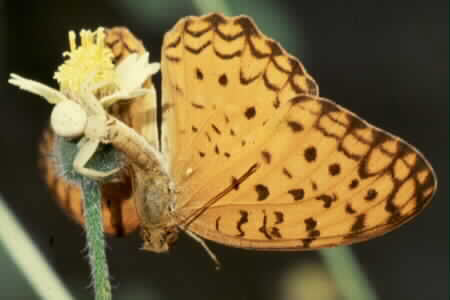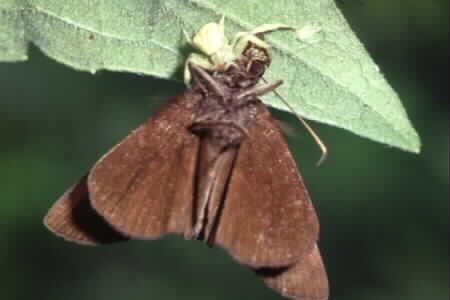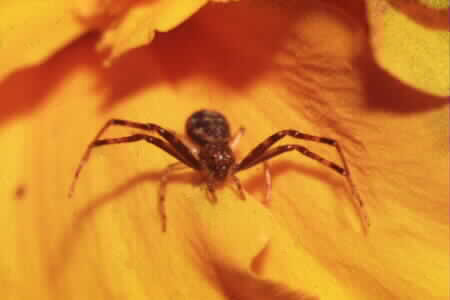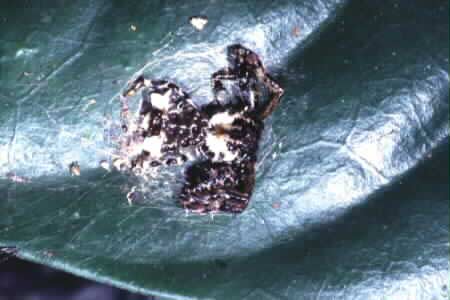






|
FOLDER 2: AMBUSH ARTISTES (CRAB SPIDERS)
CLICK ON A THUMBNAIL IMAGE TO VIEW THE LARGER PHOTO
Ambush artistes
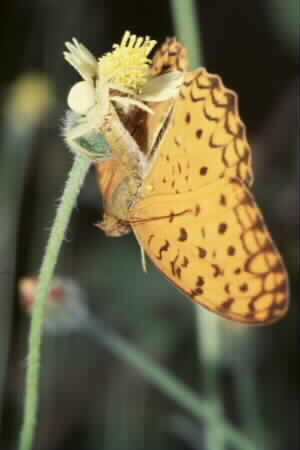 SPIDERS use various means to catch their
prey. Most of us are familiar with the gossamer webs made by many species, especially the
orb-web spiders (family Araneidae), to trap flying insects. Other species, such as the wolf
spiders (family Lycosidae) and jumping spiders (family Salticidae), actively hunt their prey,
which may include other spiders.
SPIDERS use various means to catch their
prey. Most of us are familiar with the gossamer webs made by many species, especially the
orb-web spiders (family Araneidae), to trap flying insects. Other species, such as the wolf
spiders (family Lycosidae) and jumping spiders (family Salticidae), actively hunt their prey,
which may include other spiders.
Some species employ rather unusual methods. For example, spitting spiders
(family Scytodidae) spray a glue-venom mixture from their fangs to immobilise their victims.
Net-casting spiders (family Dinopidae) weave small silk webs, or nets, which they use to catch
insects.
A net-casting spider, holding its net with its front four legs, waits for
its prey as it hangs upside-down and close to the ground. When an insect passes underneath,
it lunges down and stretches the net over the victim, trapping it to the ground. The struggling
insect is then paralysed with venom from the spider’s fangs.
In contrast, crab spiders (family Thomisidae) neither hunt actively nor use
traps or nets to ensnare their prey. Being slow-moving creatures, they resort to ambush to get
their meals. They wait absolutely still, usually on flowers, for some unsuspecting insect to land
in front of them, and then they strike.
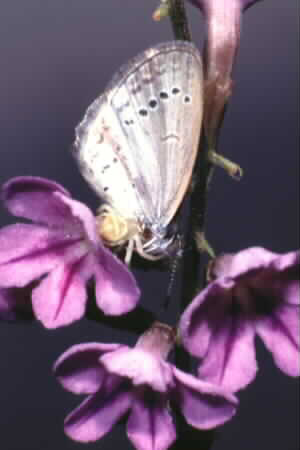 The victims are usually nectar feeders, such as butterflies, or pollen
collectors, such as bees, which are attracted to flowers. These insects could be many times
bigger than their predators. But crab spiders have long and thick front legs armed with spines
that are effective for grasping prey. And the struggling insects are quickly overwhelmed with a
venomous bite.
The victims are usually nectar feeders, such as butterflies, or pollen
collectors, such as bees, which are attracted to flowers. These insects could be many times
bigger than their predators. But crab spiders have long and thick front legs armed with spines
that are effective for grasping prey. And the struggling insects are quickly overwhelmed with a
venomous bite.
So far, I have seen and photographed three crab spiders, measuring one
centimetre or less in length, tackling butterflies much larger than they were.
Sometimes the crab spiders are aided by camouflage; their colours match those
of the flowers on which they lie in ambush, making them virtually invisible. Even without the
benefit of camouflage, crab spiders still manage to catch insects, a testimony to their skill as
wait-and-catch predators.
Some species of crab spiders are clever mimics. The Bird-Dung Crab Spider has
a black, wet and lumpy look like that of fresh bird faeces. This deception is enhanced when the
spider sits on a patch of white silk simulating the uric-acid paste typically found in bird
droppings. This bluff is intended to lure flies and other insects which feed on bird droppings
for the salts they contain.
The Ant-Like Crab Spider mimics the ferocious weaver ant, or kerengga,
and preys on them at night ... which goes to show that imitation may not always be the most
sincere form of flattery but something else quite sinisters.
Crab spiders are so called because they walks sideways like crabs do.
(This article was published in the December 1997 issue of Journal One.)
|
 
This page revised on 22 March 2003. Copyright © Chin Fah Shin
|







